Potřebujeme váš souhlas k využití jednotlivých dat, aby se vám mimo jiné mohly ukazovat informace týkající se vašich zájmů. Souhlas udělíte kliknutím na tlačítko „OK“.
ASTM F1414-13
Standard Test Method for Measurement of Cut Resistance to Chain Saw in Lower Body (Legs) Protective Clothing
Automaticky přeložený název:
Standardní zkušební metoda pro měření odporu Střih na pilu dolní části těla (nohy) ochranné oděvy
NORMA vydána dne 1.1.2013
Informace o normě:
Označení normy: ASTM F1414-13
Poznámka: NEPLATNÁ
Datum vydání normy: 1.1.2013
Kód zboží: NS-50207
Počet stran: 15
Přibližná hmotnost: 45 g (0.10 liber)
Země: Americká technická norma
Kategorie: Technické normy ASTM
Anotace textu normy ASTM F1414-13 :
Keywords:
chain saw, cut resistance, lower body, protective clothing, ICS Number Code 13.340.10 (Protective clothing)
Doplňující informace
| Significance and Use | ||||||||
|
5.1 The purpose of this test method is to provide a measurable criterion of performance about the level of cut resistance provided by different types of protective garments and protected coverings worn by chain saw operators. 5.2 This test method is intended to show to what level a protective garment can offer resistance to the cutting action of a chain saw. 5.3 The protection which can be demonstrated by the garments and coverings tested in accordance with this test method is achieved by: (1) the cut resistance of the material to cutting when put in contact with saw chain; (2) pulling a part of the material or yarns in the material so that they are drawn into the chain and drive mechanism to block the chain movement; (3) the fibers of the materials used to demonstrate both high resistance to cutting and the capacity to absorb rotational energy, so that chain speed can be slowed down sufficiently to stop the movement of the saw chain; or (4) any combination of these. 5.4 This test method does not purport to evaluate comfort of lower body protective garments. 5.5 In case of a dispute arising from differences in reported test results when using this test method for acceptance testing of commercial shipments, the purchaser and the supplier should perform comparative tests to determine if there is a statistical bias between their laboratories. Competent statistical assistance is recommended for the investigation of bias. As a minimum, the two parties should take a group of test specimens from the same lot of components to be evaluated. The test specimens should then be randomly assigned in equal numbers to each laboratory for testing. If a bias is found, either its cause must be determined and corrected or the purchaser and the supplier must agree to interpret future test results in light of the known bias. |
||||||||
| 1. Scope | ||||||||
|
1.1 This test method measures cut resistance of garments and devices worn to protect the lower body (legs) when operating a chain saw. 1.2 This test method may be used to test for compliance to minimum performance requirements in established safety standards. 1.2.1 By agreement between the purchaser and the supplier, or as required by established safety standards, it will be decided if this test method will be used to determine one or both of the following: (1) chainspeed 50 (CS50), and (2) success/failure (jamming/chain stop or no cut in less than 1.5 seconds) at specified chain speed. 1.3 This test method may be used to determine levels of protection for areas of coverage as stipulated in established safety standards. 1.4 The values stated in SI units are to be regarded as standard. 1.5 This standard does not
purport to address all of the safety concerns, if any, associated
with its use. It is the responsibility of the user of this standard
to establish appropriate safety and health practices and determine
the applicability of regulatory limitations prior to use.
|
||||||||
| 2. Referenced Documents | ||||||||
|
Odebírejte informace o nově vydaných normách ZDARMA:
Chcete pravidelně odebírat informace o nově vycházejících normách z celého světa a to zcela zdarma?
Přihlašte se k odběru. Vše je velice jednoduché a absolutně ZDARMA.
Na výběr máte vydavatele z celého světa.




 Cookies
Cookies
